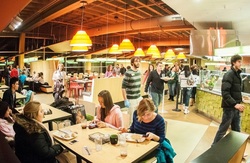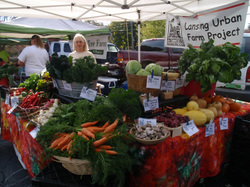 4th Food Ethnography
In the East Lansing area there are many options for places to eat, some with pizza, some with chicken teriyaki stir-fry’s. Most often these eateries are separate, but there is a select few locations where you can get these odd food combinations. There are ten of them to be exact. They are Michigan State University’s Cafeterias. Four of the ten are not your typical wait in one line cafeterias. These four renovated cafeterias have upgraded to become “five star” cafeterias featuring any food you can think of, and lots of it. The newest addition to the cafeterias was a renovated, Shaw Hall Cafeteria, or as Michigan State labeled it “The Vista at Shaw Hall”. To better understand the culture of Shaw Cafeteria I walked out of my dorm room and walked about 250 feet to take a closer look at Shaw Cafeteria.
As I made my way into the cafeteria I was greeted with a smile and a hello by the card swipe lady. Then it hit me, the feeling of being almost overwhelmed by all the options and not knowing where anything was. Shaw Cafeteria had seven different stations to be exact, all featuring different foods. While I had this feeling of being slightly overwhelmed; I also had excitement over all the potential foods I could eat. My feeling of being overwhelmed quickly subsided when I noticed the cafeteria had television screens showing what each station featured. As I was going to make my food choice I noticed something missing that almost every cafeteria I had ever been too had. Trays, as a green initiative Shaw Cafeteria decided to go tray less to reduce the amount of food waste. This was also for the students to potentially reduce the overall amount of food eaten if they have less on room to carry food. Whether or not actually going tray less would reduce these effects, I did not know yet.
I grabbed some fresh baked pizza and some tofu stir fry, and sat down in the elevated center seating with my roommate. I then sat back and realized the design of the seating area reflected the main food station it was around. “Garden Wok” a station featuring vegetarian and Asian options. It had a seating section that featured mainly wooden furniture and had a more natural simple design to it. “Main Street” is a station with typical American meals, and the seating section is full of huge booths that create a modern American environment. As for the food itself I would say it the best of all the Michigan State cafeterias. Shaw Cafeteria ever since it opened has always seemed to have fresh more creative menu items than the typical Michigan State cafeteria.
Shaw Cafeteria was unlike any of the other three places I visited for the food ethnographies, mainly because it was mostly filled with my peers. The typical customer at the cafeteria was a college student either having dinner with some friends, or eating alone and getting some homework done. Some lived in Shaw Hall so they were dressed in gym shorts and a t-shirt while others came from other dorms and were dressed for the cold, in jeans and a sweater. As for the price every on campus student is forced to have a meal plan starting out at $2,585, which breaks down to about twenty five dollars a day. This is a lot of money especially to a college student but, it does not affect who eats at the cafeterias because every on campus student has to purchase a meal plan. There was not one dominant type of person in the cafeteria, because the cafeterias are where every on campus student has to eat.
As I reflect on the experience as whole the biggest thing that struck me was going tray less. The tray initiative that Shaw Cafeteria put in to place was effective at least on an individual level, I ate less than I would if I were at a Michigan State Cafeteria that did have trays. The reason for this is something we discussed in our readings and in class. If we have to go up and get seconds then we feel as if we are being gluttons, but if we can pile a bunch of food onto one tray and not have to go for seconds it seems fine. This happened to me at Shaw Cafeteria, I did not want to get up for seconds because I felt as if I would be overeating and I could not load up a tray because I simply did not have one. Shaw Cafeteria presented a tough challenge to find dominate cultural factors because of the number of options they had and also the number of different types of people in the cafeteria.
 Vegetarian Cookbook Project
“Nothing will benefit human health and increase chances for survival of life on Earth as much as the evolution to a vegetarian diet”, wrote Albert Einstein. Vegetarianism in its most basic definition is a diet excluding meat; from these basic guidelines stem many different variations of vegetarianism. The arguments for a vegetarian diet vary widely, and here are just a few of the reasons: religion, animal rights, cultural preferences, money or even feminism. One of the most popular arguments for a vegetarian diet is the positive health effects. These health effects are not just based on the health of the individual vegetarian, but on the environmental health of the world. Although the argument for the health of the individual has been around for a while the overall health of the environment argument is one that has grown from the industrialization of the food system.
To get a better understanding for the argument supporting the health benefits of vegetarianism, vegetarian cookbooks are good resources to look at to find a variety of arguments. Vegetarianism for the Working Person is a cookbook/guidebook for how to cook simple vegetarian dishes and it is also a guide of where to find vegetarian options on the go. This book was written in the mid 1980’s; it argues, almost exclusively, about the individual health benefits. The author’s goal was to inform the reader that vegetarianism can be an actual long-term diet. “The American Dietetic Association has affirmed that a vegetarian diet can meet all known nutrient needs” (Stahler). The prevailing thought amongst most people during this time was that meat products were needed to have a complete diet and to eat a meatless diet would be bad for your health. The cookbook makes no arguments about environmental health benefits. During the, mid-1980’s the industrial food system was booming, but the negative externalities of the system had yet to be fully realized. The cookbook actually supports the use of the industrialized food system; the first quarter of the book is devoted to finding vegetarian options at different places, mostly fast food restaurants. The industrialized food system was in full swing during this time, but the harmful short term and long term effects had not been realized.
To find out how the health argument had changed since the mid-1980’s, two other cookbooks were analyzed. One from 1995, Linda’s Kitchen: Simple and Inspiring Recipes for Meatless Meals ,and the other was a book originally written in 1997 called Student's Vegetarian Cookbook: Quick, Easy, Cheap, and Tasty Vegetarian Recipes. Both of these cookbooks present the argument of health as the main reason for becoming a vegetarian, but they present their arguments to a different crowd and in a different manner. Student’s Vegetarian Cookbook was written for students who are beginning their journey into vegetarianism who are looking for quicker and more simple recipes to make while balancing the life of a student. The cookbook’s author mostly talks about the negative environmental health effects of eating meat, and how if you eliminate meat from your diet it can help the world, as well as yourself. The cookbook has a strong underlying tone portraying the “evilness” of the current food industry, arguing that it is not sustainable and it uses many statistics to show its negative effects.
Linda’s Kitchen argued much of the same as Student’s Vegetarian Cookbook, except it felt as if it was geared to a more sophisticated crowd than students. The recipes seemed gourmet and more complicated to make than the previous two cookbooks. The author Linda McCarthy stressed that becoming a vegetarian was a great new way of life that not only would help to save your life but also the planet’s. She rejected the industrial food system, and made sure the reader knew that the current way of producing food specifically meat was unsustainable.
The most interesting part of the three cookbooks is the addition of the environmental health argument from the earlier cookbook as opposed the two cookbooks from the mid to late 1990’s. The earlier cookbook actually advocated using the industrialized food system to help be a “working person” vegetarian, by using fast food restaurants to eat vegetarian. A lot of knowledge was gained in that ten year period between the books and that can be seen. Although there is still some skepticism, mostly among staunch meat eaters, of a vegetarian diet being a complete healthy diet. The latter two cookbooks featured environmental arguments for becoming a vegetarian rather than just strictly the individual health. The vegetarian diet, according to the health argument presented in the cookbooks has become an anti-industrial food movement, pushing vegetarians to reject the food industry.
Works Cited
McCartney, Linda. Linda's Kitchen: Simple and Inspiring Recipes for Meatless Meals. New York: Arcade Pub, 1995. Print.
Stahler, Charles, and Debra Wasserman. Vegetarianism for the Working Person: Quick and Easy Vegetarian Recipes. Baltimore, MD: Baltimore Vegetarians, 1986. Print.
Raymond, Carole. Student's Vegetarian Cookbook: Quick, Easy, Cheap, and Tasty Vegetarian Recipes. New York: Three Rivers Press, 2003. Print.
 3rd Food Ethnography
A tavern to the average American is a restaurant where people mainly go to drink alcoholic beverages, enjoy some decent food, and gather with friends. For the most part in my twenty years of living, every tavern I have gone to has been almost exactly as I just described. The classic tavern that I had grown accustomed to was not what I found on my visit to Tavern 109, in Williamston, Michigan. One of the biggest growing trends in the United States restaurant industry is the use of fresh-local sourced food. Tavern 109 is one of the restaurants that believes in local ingredients making better food. My family and I made the trip down Grand River to Tavern 109 to experience first-hand what it was like to eat at a locally sourced restaurant.
From the moment I walked in I could tell this was not your typical downtown tavern, there was a smell of fresh food being made (I think it was some sort of apple dessert) instead of the traditional beer and peanuts scent. The tavern is located in a restored historic bank building in downtown Williamston and the architecture definitely added to the whole experience. When we walked in the immediate feeling I got was comfort, the old brick walls, a fireplace dividing the two sides and a semi-open kitchen gave the restaurant a cozy feeling I could not deny. As I was feeling all cozy, I realized that the restaurant was different from all of the prior food ethnography locations. This was the most “upscale” location I had been, not in the fifty dollars for a steak upscale sense, but Tavern 109 was “upscale” in the sense that it was somewhere that people go to have a relaxing locally sourced meal and sip on a craft beer.
The most important part of the whole experience was the food; I had gone to “Fork in the Road” before so I had high expectations for Tavern 109 being a restaurant with locally sourced meal options. The menu had a plethora of options that I thought sounded delicious, and many of the dishes they featured had me excited to eat. I was deciding between the shrimp and grits (locally sourced Okemos farmed shrimp) or the P.G.L.T (prosciutto, goat cheese, arugula, and tomato) pizza, eventually I settled on the pizza. The menu conveyed Tavern 109’s commitment to creating traditional tavern dishes with a creative spin and local ingredients when possible. Every dish I saw being brought out from the kitchen looked delicious from the fish and chips to the barbeque burger. As I was reflecting on all the food I went back to some of the original thoughts I had about Tavern 109 being “upscale”.
I use upscale in quotes as I had mentioned above not because of the prices, because everything on the menu had a “fair” price entrees around fifteen dollars and burgers around eleven dollars. Now these prices are a bit expensive relative to some of the local taverns, the overall environment is what made Tavern 109 “upscale”. The people in the tavern were mostly white middle to upper-middle class adults with only a small handful of kids. At least this was my perception from the attire of all the customers, generally dressed in clothing described as business casual. I felt almost underdressed in my jeans and Michigan State crewneck sweatshirt, but I did not feel as if I was out of place. Some of the customers seemed to be out on a date while others seemed to be meeting their friends for dinner minus the kids. The lack of kids is one of the largest reasons Tavern 109 seemed “upscale”. Most restaurants on a Tuesday at 6:00 PM will have all kinds of kids running around, Tavern 109 did not.
As I am writing and reflecting back on the “upscale” theme that I have been talking about for most of the paper I connected thoughts in my head to much of what I have been learning about in class. The local sourced food movement is still relatively small and also considered to be a sort of a Foodie movement for the middle to upper class to have fresh healthy food when they want it. Tavern 109 is one of those places that has magnified this thought of locally sourced food being an option for the middle to upper class citizens. The lack of kids to me can be explained by much of our discussion in the beginning of class on how the typical Americans believe most kids only like “simple” foods, like hot dogs, chicken nuggets and macaroni and cheese. By this American logic, taking your kids to a restaurant like Tavern 109 seems like a waste because they would not appreciate the great unique tastes that are associated with many of the dishes. Tavern 109 had the “upscale” feeling to me because of the above mentioned things, but I believe as the local food movement continues to grow Tavern 109 will just be seen as another great place to enjoy locally sourced food.
 2nd Food Ethnography
Americans once shopped for food in a completely different manner then they do today. Once upon a time Americans would run down to their local market or corner store and get what food they needed for the day or next couple of days. Today’s typical Americans run to the local Wal-Mart, Kroger, Costco, or any other supermarket located in most towns across America and get the food they needed for the next couple of weeks. Most of these changes have occurred over the past 50 years, as Americans began to rely on a small number of farmers and food companies to provide the food to these “super” supermarkets. Leaving many small-scale local farmers to “die” and for the most part small farms did, but not all small farms did “die”. In fact the small local farmer seems to be making resurgence, in the form of farmer’s markets. What has allowed farmer’s markets to enjoy this resurgence? To find out this answer I took a trip to the Allen Street Farmer’s Market in Lansing to discover what makes farmer’s markets so unique.
As I walked up to Allen Street on a cold, sleet-filled Wednesday in October, one thing popped in my head; although it was a crumby day everyone present seemed to be happy. Everyone there was actually happy or at least put on a good act, as I came to find out through interactions with most of the vendors. My ignorance of farmer’s markets had me under the impression that they strictly featured only fruits and vegetables with a little bit of meat. As I walked around I soon realized it was much more than that. I made my way to Stone Circle Bakehouse, a local bread company out of Holt using simple ingredients to bake breads “the way they once tasted” (Stone). As I talked to the individuals running the stand I realized just how different the culture was at a farmer’s market compared to the supermarkets that most Americans shop at.
The people at the stand were friendly and genuinely excited to tell me about their products natural ingredients and fresh taste. They had successfully roped me in to buying some bread and my spending did not stop there as I sprung for some other products along the way. The environment had my interest peaked. The people made a huge difference, but ultimately knowing where all the food came from was the biggest factor for me. 1500 miles is the average distance food travels in the United States before it gets to us (the consumers) according to many locavore movements. From my baseline information of the Allen Street Farmer’s Market the food was traveling no more than 30 miles and as little as a couple of blocks, where some of the urban farmers grow their produce.
Because this food comes from local producers, people can sometimes have the misconception that farmer’s markets are only for people who are willing to spend lots of money on food. As I was walking around, I noticed the prices of the fruits and vegetables and they seemed reasonable, according to my limited knowledge of fruit and vegetable prices. Even if they were a bit more expensive, to me it seemed worth it to know that my food was coming from somewhere close and it would be helping people within the community. Also, as I discovered that at each stand they accepted bridge card tokens and food stamp tokens, therefore making it more accessible to lower income individuals. As I was buying products I realized that it was alright to negotiate for them, something that had completely caught me off guard. This was one of the biggest and best cultural differences between the traditional American supermarket and the Allen Street Farmer’s Market.
As I was walking away from the farmer’s market my mood can be described simply as jolly, I had never left somewhere that I bought food feeling so satisfied and happy. The culture of the farmer’s market had brightened my day, from the people, to the products, to the excessive amount of “hippie” bumper stickers. I realized that having the counterculture to the American supermarket was what had made my experience so great and has allowed farmer’s markets to grow across America. Although my experience as a whole was great, I see a large flaw in farmer’s markets especially in northern states. Most are only open from May to October; therefore, forcing people to turn to the traditional supermarket where the food is often not as fresh and travels on average 1500 miles. Ultimately, I think farmer’s markets are a great long-term supplement to American supermarkets, somewhere we can all go to get local fresh food products.
Work Cited
"Agricultural Marketing Service - Farmers Markets and Local Food Marketing." Agricultural Marketing Service - Farmers Markets and Local Food Marketing. USDA, 3 Aug. 2013. Web. 28 Oct. 2013.
"Stone Circle Bake House." Stone Circle Bakehouse. N.p., n.d. Web. 30 Oct. 2013. <http://www.stonecirclebakehouse.com/>.
 McDonaldization Project
McDonaldization has become a large part of many aspects of American society as well as societies throughout the rest of the world. In fact, George Ritzer in The McDonaldization in Society argues there are very few places in society that have not been affected by the fast food industry’s principles. What happens when someone tries to break the mold of McDonaldization that has taken over so many parts of society? Does the world come crashing down around us, do people tend to give into your demands or do people simply laugh it off as something that is more of a joke? During this paper I will dive into an “art” that has been all but lost in American society; the “art” of negotiation. Other than for large purchases like a house or a car, most Americans will not approach negotiation in purchases; I will discuss my adventures into negotiating for everyday products that most Americans buy.
Negotiation was chosen because it is an “art”, as I call it, that has been almost completely eliminated from American society. As a whole we have accepted prices printed in stores as law and we have given no thought as to why. For my first experiment into negotiation I started on a small scale, Sparty’s, the small convenience stores located all around campus. I had a goal to obtain three cookies for a reduced rate by convincing the workers that I should get a discount rate for buying in “bulk” (relative to the typical student who would only purchase one cookie). Long story short, I was unsuccessful in my attempt. The workers at Sparty’s simply have no authority to negotiate and there was no manager present in the small convenience store. As I was negotiating I felt as if they wanted to make the deal but their “McJobs” were so structured that it leaves them no room for any creativity or power. The people around me, much like the workers found it funny that I was seriously attempting to negotiate for cookies. They were so used to the typical McDonaldized way of paying the stated price as opposed to negotiating for a better price.
The first attempt was a failure. I did not negotiate a better price, but I did learn I needed to attempt negotiation at a different location under different circumstances. I needed to go to a store or restaurant where I could speak with a manager or to someone with power or guts to actually negotiate with me. So naturally I took my negotiation “talents” to the Meijer in my home town, Lake Orion. I went in with the same tactic as at Sparty’s I was going to get a discount by buying in “bulk”. This time I was going to negotiate for three gardening hoes, a definite odd purchase for any college student.
As I was walking down the gardening aisle the nerves were far more present at Meijer then at Sparty’s, because I was no longer dealing with students at an on campus job. I was going to be negotiating with an adult at his or her full time job. I was finally able to locate an employee after a few minutes of searching (who happened to be a manager) to discuss the discounted rate for the three garden hoes. Once again, much like my first attempt at Sparty’s, I was unsuccessful. The manager that I talked to was not willing to negotiate the price, although he did find it funny and courageous who I wanted to negotiate the price. Unfortunately, there was no one around me to see swing and miss in my attempt to negotiate with the manager, but if someone was, I could imagine they would have would have had a similar reaction to the people I was around at Sparty’s.
As I sit back and reflect on the experience at both locations I cannot help but think about how American culture has distanced itself from negotiation for everyday products. Like many other aspects of American society, McDonaldization has become a part of how we shop. It is much easier for stores if everybody has to pay the same prices. They do not have to train their employees how to bargain, and they do not have to worry about their stores somehow getting “ripped off” in negotiation. For the customers, it is easier to go into the store, pick up everything they need and not have to negotiate for anything. Speed and efficiency is what the customers and producers think they want, but what the customers are losing out on by not negotiating is money and potentially lots of it. Although it was awkward to try and negotiate for everyday products, I think it is something that more people should do in order to break the McDonaldization mold in today’s society.
 1st Food Ethnography
The largest increase of foreign students on Michigan State University’s campus in the past five to ten years has come from the Asian population, specifically students from China. In the 2012-2013 academic year the number of Chinese students totaled 3,712; this number is much larger than the 891 students that were on campus for the 2007-2008 academic year (International). With this influx of Chinese students and families to MSU and the surrounding areas, the market for “authentic” (authentic being a topic discussed later in the ethnography) Chinese restaurants, grocery stores, and other Chinese stores has greatly expanded. As I began to explore this new cultural explosion I came upon one of the many restaurants the Michigan State Chinese population visits. Everyday Restaurant Chinese Cuisine is far different from most Americanized Chinese restaurants, such as PF Chang’s, Panda Express or the typical Chinese restaurant that is in towns across America. Typical Americanized Chinese restaurants serve food such as sesame, sweet and sour, and Kung Pao chicken with a side of white or chicken fried rice.
How is Everyday Restaurant Chinese Cuisine different from some of the typical American Chinese restaurants? The simple and not so simple answer is the culture of the restaurant, from the wait staff, to the food, to the frequent customers (Asian students). The culture of the restaurant is what gives it the “authentic” feeling. “Authentic” meaning Everyday Restaurant Chinese Cuisine presents a similar culture of eating as you would experience at a restaurant in China. As I walked into the restaurant, the first thing that came to my attention was the restaurant was completely full of Asian people mostly students and the occasional older couple scattered throughout. Also as customers, including myself, were being seated, I noticed that English was being spoken by none of the employees. The employees and Asian customers often engaged in conversation when they were being seated as if they knew each other. The patrons and employees in the restaurant were some of the first clues that Everyday Restaurant Chinese Cuisine is culturally “authentic”, if this restaurant were a run of the mill Americanized Chinese restaurant there would not be such a high of a concentration of Asian population. As the meal continued the Chinese culture of the restaurant was evident at almost every point.
The language barrier caused quite a problem, as a non-Asian customer, problems arose as I tried to ask for suggestions, the waitress had limited knowledge of English so she had to find another employee who came over and immediately pointed to the American Chinese food on the menu. A simple flip through the menu would have many Americans wondering what in the world is that, or why would anyone ever eat that? From duck, intestines, chicken feet, hot pots, to liver, they had it all on the menu. I looked around the Asian customers were eating these different exotic (exotic to me) dishes. I tried to communicate to the waiter that I did not want to have the typical American Chinese food; I was there to try Chinese food the typical Chinese customer would eat when they visited. He pointed me in the direction of a noodle dish with many different types of meat and seafood, which I decided to order, and found the dish to be alright. I had left my comfort zone and experienced an “authentic” Chinese meal.
As I was making the conscious effort to experience the full culture of the restaurant, I intently observed the other customers and their actions throughout the night. The typical customer at the Everyday Restaurant Chinese Cuisine did not seem to be of particularly high social class; most were dressed in regular casual clothing and were eating with a few friends. The prices also dictated that the restaurant was not especially fancy; most items were under $12 with the occasional entrée like duck around $20. These prices allowed many different classes of people to eat at the restaurant.
As my observations continued I focused on how the customers were eating and interacting with each other. Out of these observations I discovered something that may have been the biggest difference between American and Chinese culture. Almost every table was sharing their meal; the main dishes were in the center of the table in a large bowl and each person had a separate smaller plate that they would put the main dishes on. As I reflected on this, I concluded that the way the Chinese culture eats seems to be much more intimate in regards to eating with groups. This intimacy is something that American culture typically only sees at family dinners, but the Chinese culture has this in many parts of their eating culture. From my observations I concluded, the Chinese make eating with friends a far more intimate moment than the typical Americans eating with friends.
The overall experience I had at the Everyday Restaurant Chinese Cuisine was “authentic”. I felt throughout the meal that I was in Shanghai going to a local restaurant, ordering the local food, and watching the local people interact. The culture within the restaurant was unlike any Chinese place I had ever gone and this culture was what attracted the Chinese students, an “authentic” feeling of home.
Works Cited
International Students By Country of Origin: Asia. Rep. Michigan State University, n.d. Web. 28 Sept. 2013. <http://oiss.isp.msu.edu/documents/statsreport/12pdfs/Asia.pdf>.
 Kevin’s Food Autobiography
Rocky Mountain oysters (buffalo testicles), may be the oddest food Kevin can remember eating in his almost twenty years of living. Kevin has no fear of any food. He will try anything you put in front of him and he believes this fearlessness in the food realm stems from his father’s fondness of trying just about anything. Although Kevin will try whatever you put in front of him, he will not always enjoy it. In fact, he still holds onto a few of the same food aversions today that he did as a child. Kevin’s eating habits have come a long way from his younger years, when the simple truth was he had a general dislike of almost every fruit and vegetable. Today’s Kevin enjoys most foods although he still has the slight childhood fear of fruits stemming from his younger years of life.
It is important to understand how Kevin gained the food habits he had as a kid and learning about moments in his life that helped to expand and create the eater he is today. Kevin’s habits, tastes, and aversions can be attributed almost exclusively to his surroundings, mainly his family. Up until middle school Kevin could be classified as the typical American kid of the late 90’s or early 2000’s. Kevin like many other young kids of his age group enjoyed any kind of meat, pasta, bread, or any other non-fruit or non-vegetable you gave him. These aversions too fruit can be drawn from Kevin’s family. No one in his family was ever a huge fruit eater, and so as a child Kevin was not exposed to lots of fruits. As a child he thought they all had a bland taste and an even worse texture.
How Kevin became the eater he was as a child can be traced to his family’s eating habits; specifically, the eating habits of his grandparents. Kevin remembers when he would go stay with his grandparents for a couple weeks during the summer each year, and his grandma would make meals filled with onions and other vegetables. Kevin couldn’t stand these meals as a child because they featured such food items, but worst of all Kevin’s grandmother wouldn’t let him leave the dinner table until his plate was empty. The feeling of being forced to eat food made Kevin dislike fruits and vegetables even more. Although his grandma was only trying to help Kevin have better food habits, it ultimately created a regular occurring event that Kevin dreaded. In hindsight, these actions hurt his food eating development as a child. For years this went on and it was not until Kevin got into that his middle school years did his food tastes and habits develop.
The singular moment when Kevin’s eating habits began to finally expand can be traced back to seventh grade and a trip to a neighborhood friend’s house for dinner. Typically, they ate what he liked such as, pizza, hamburgers, and pasta, but on that night they had something Kevin had never tried, chicken Caesar salad. Now Kevin was faced with two options: not eat and go hungry or force himself to eat the “dreaded” vegetable called lettuce, which he never ate simply because it had no taste, and he did not like the crunch of it. Kevin chose to eat the salad and to his surprise he realized that salad was not as bad as he had made it out to be in his head. Kevin’s first “leap” into salad opened the door to ending his childhood eating habits; soon he was eating broccoli, cauliflower, carrots, corn, and his personal favorite, asparagus. Why was Kevin able to try salad at this moment in his life rather than earlier? It was the perfect storm for changing his food habits. He had reached the age in his life when he was trying new things all the time and food was one of those “new things.” Also when teenage boys are around their friends they never want to show they are afraid of new things. Reaching this point in Kevin’s life was critical to establishing the type of eater that he has become today.
Today, Kevin does not necessarily have a specific label as an eater, he will eat everything; sometimes too much of everything. He often has the problem of overeating, which is a common problem among Americans today as seen by the rise of obesity across the country. Kevin runs about two miles a day, he justifies in his head that he can eat whatever he wants because he will just run it off the next day. Every so often Kevin has a period of about a couple of weeks to a month where he will try to eat more healthy, steering clear of the fried and over processed foods and sticking to salads and other healthier options. In order to take his food habits to the next level Kevin hopes to move from periods of healthy eating to eating healthier at all times in his life. Kevin’s family and his cultural surroundings have shaped his eating habits from the day he was born and continue to play a role in how he eats today. As Kevin continues to grow up and learn more about the negative effects of eating poorly he challenges himself to implement eating healthier foods into his everyday lifestyle in order to help him live a longer happier life.
Kevin can honestly say he has learned more about food in the past three and a half months then he has in the past three and a half years. He has never been one to critically think about his eating habits, from what are the specific foods he eats health affects to where does the food come from. This has been the biggest change that ISS 310 has brought to Kevin’s life and he believes it could be a great change in his life. Kevin will never completely stop his consumption of meat, but he now practices reducing his meat intake in his daily diet, and has been successful over the past couple of weeks. The most important piece of information that Kevin will take away from class is that food is not something that should just be thrown in our bodies to fill us up. Food is something that should have a more important focus in Kevin’s life, and help to make him healthy while he helps to make the world more sustainable.
|







 RSS Feed
RSS Feed